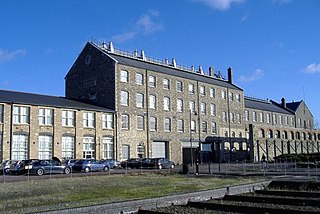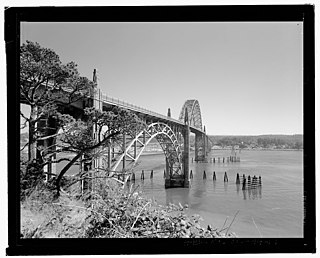
In the United Kingdom, a scheduled monument is a nationally important archaeological site or historic building, given protection against unauthorised change.

In the United Kingdom a listed building is a structure of particular architectural and/or historic interest deserving of special protection. Such buildings are placed on one of the four statutory lists maintained by Historic England in England, Historic Environment Scotland in Scotland, Cadw in Wales, and the Northern Ireland Environment Agency in Northern Ireland. The term has also been used in the Republic of Ireland, where buildings are protected under the Planning and Development Act 2000, although the statutory term in Ireland is "protected structure".
Brutalist architecture is an architectural style that emerged during the 1950s in the United Kingdom, among the reconstruction projects of the post-war era. Brutalist buildings are characterised by minimalist constructions that showcase the bare building materials and structural elements over decorative design. The style commonly makes use of exposed, unpainted concrete or brick, angular geometric shapes and a predominantly monochrome colour palette; other materials, such as steel, timber, and glass, are also featured.

Victorian architecture is a series of architectural revival styles in the mid-to-late 19th century. Victorian refers to the reign of Queen Victoria (1837–1901), called the Victorian era, during which period the styles known as Victorian were used in construction. However, many elements of what is typically termed "Victorian" architecture did not become popular until later in Victoria's reign, roughly from 1850 and later. The styles often included interpretations and eclectic revivals of historic styles (see Historicism). The name represents the British and French custom of naming architectural styles for a reigning monarch. Within this naming and classification scheme, it followed Georgian architecture and later Regency architecture, and was succeeded by Edwardian architecture.

Historic preservation (US), built heritage preservation or built heritage conservation (UK), is an endeavor that seeks to preserve, conserve and protect buildings, objects, landscapes or other artifacts of historical significance. It is a philosophical concept that became popular in the twentieth century, which maintains that cities as products of centuries’ development should be obligated to protect their patrimonial legacy. The term refers specifically to the preservation of the built environment, and not to preservation of, for example, primeval forests or wilderness.

Conservation and restoration of immovable cultural property describes the process through which the material, historical, and design integrity of any immovable cultural property are prolonged through carefully planned interventions. The individual engaged in this pursuit is known as an architectural conservator-restorer. Decisions of when and how to engage in an intervention are critical to the ultimate conservation-restoration of cultural heritage. Ultimately, the decision is value based: a combination of artistic, contextual, and informational values is normally considered. In some cases, a decision to not intervene may be the most appropriate choice.

In British law, an ancient monument is an early historical structure or monument worthy of preservation and study due to archaeological or heritage interest. The Ancient Monuments and Archaeological Areas Act 1979 classified ancient monuments as "scheduled monuments" or monuments that are considered by the Secretary of State of archaeological, historical or artistic importance.

The Georgian Group is a British charity, and the national authority on Georgian architecture built between 1700 and 1837 in England and Wales. As one of the National Amenity Societies, The Georgian Group is a statutory consultee on alterations to listed buildings, and by law must be notified of any work to a relevant listed building which involves any element of demolition.
Colin McWilliam (1928–1989) was a British architecture academic and author.

The Historic England Archive is the public archive of Historic England, located in The Engine House on Fire Fly Avenue in Swindon, formerly part of the Swindon Works of the Great Western Railway.

George Corson (1829–1910) was a Scottish architect active in Leeds, West Yorkshire, England.
An annual Heritage at Risk Register is published by Historic England. The survey is used by national and local government, a wide range of individuals and heritage groups to establish the extent of risk and to help assess priorities for action and funding decisions. This heritage-at-risk data is one of the UK government's official statistics.

Malcolm Fraser is an architect from Edinburgh, Scotland. He was the founder of Malcolm Fraser Architects, a firm of architects based in the Old Town of Edinburgh from 1993. The company entered liquidation on 21 August 2015 and Fraser worked with Halliday Fraser Munro Architects before setting up anew with Robin Livingstone as Fraser/Livingstone Architects in January 2019.
The Architectural Heritage Society of Scotland (AHSS) is a society dedicated to the protection and study of the built heritage of Scotland. It has around 1000 members and five regional groups responsible for commenting on planning applications in their area together with educational activities. The Society publishes periodically the academic journal, Architectural Heritage, together with a twice-yearly magazine addressing a wider range of built heritage-related matters.
Charles McKean FRSE FRSA FRHistS FRIBA was a Scottish historian, author and scholar.

James Burton Norman Jr. is an American photographer, author, and cultural historian.
Bridget Cherry OBE, FSA, Hon. FRIBA is a British architectural historian who was series editor of the Pevsner Architectural Guides from 1971 until 2002, and is the author or co-author of several volumes in the series.
In England and Wales, an amenity society is an organisation which monitors planning and development.
The Institute of Historic Building Conservation (IHBC) is a professional body in the United Kingdom which was formed as a charitable trust company in 1997 by members of the former Association of Conservation Officers. The object was to widen the scope of the profession from those mainly concerned with the statutory regulation of the historic environment to all those who practice professionally in historic and built environment conservation.

This article gives an overview of the structure of environmental and cultural conservation in Scotland, a constituent country of the United Kingdom.











